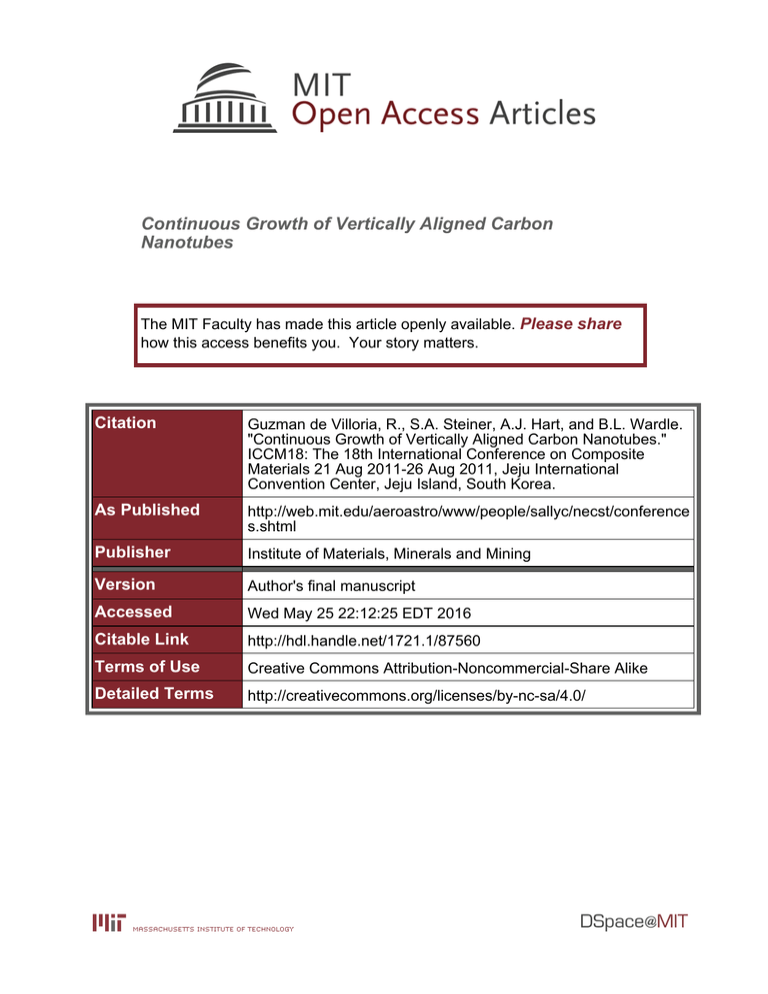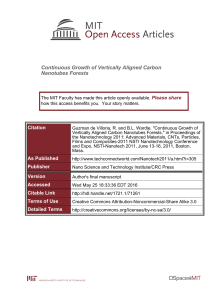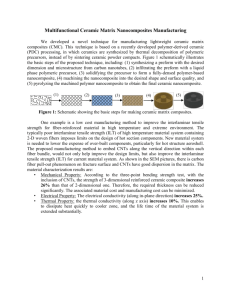Continuous Growth of Vertically Aligned Carbon Nanotubes Please share
advertisement

Continuous Growth of Vertically Aligned Carbon Nanotubes The MIT Faculty has made this article openly available. Please share how this access benefits you. Your story matters. Citation Guzman de Villoria, R., S.A. Steiner, A.J. Hart, and B.L. Wardle. "Continuous Growth of Vertically Aligned Carbon Nanotubes." ICCM18: The 18th International Conference on Composite Materials 21 Aug 2011-26 Aug 2011, Jeju International Convention Center, Jeju Island, South Korea. As Published http://web.mit.edu/aeroastro/www/people/sallyc/necst/conference s.shtml Publisher Institute of Materials, Minerals and Mining Version Author's final manuscript Accessed Wed May 25 22:12:25 EDT 2016 Citable Link http://hdl.handle.net/1721.1/87560 Terms of Use Creative Commons Attribution-Noncommercial-Share Alike Detailed Terms http://creativecommons.org/licenses/by-nc-sa/4.0/ 18TH INTERNATIONAL CONFERENCE ON COMPOSITE MATERIALS CONTINUOUS GROWTH OF VERTICALLY ALIGNED CARBON NANOTUBES R. Guzman de Villoria1*, S. A. Steiner, A. J. Hart2, B.L. Wardle1 1 Department of Aeronautics and Astronautics, Massachusetts Institute of Technology, 77 Massachusetts Avenue, Cambridge, MA 02139, USA 2 Department of Mechanical Engineering, University of Michigan, Ann Arbor, MI.* Corresponding author (rguzman@mit.edu) Keywords: vertically aligned carbon nanotubes, chemical vapor deposition 1 Introduction Vertically aligned carbon nanotubes (VACNTs), sometimes called forests or carpets, are a promising material due to their unique physical and scaledependent physical properties [1-3]. Continuous production of VACNTs is required for large-scale applications in electronic devices, fuel cells and structural composite materials [4] among others. Chemical vapour deposition (CVD) is the only available technique to produce large areas of VACNTs, and most of the studies done for this technique are done for stationary growth in batch CVD processing [5-7]. Recently, it has been demonstrated that there is no significant differences between the VACNTs grown at different velocities up to 1.1 mm/s in terms of quality, morphology and length using a CVD process in a custom cold wall continuous-feed reactor [8]. Here, a controlled process to synthesize aligned CNTs in a continuous manner is discussed. Uniform growth is achieved using different substrates including alumina fibers in bundle form and silicon wafers. 2 Experimental 2.1 Continuous Growth System The cold wall reactor designed to grow VACNTs at ambient pressure consists of three elements: a conveyance mechanism to move the substrate continuously, a controlled heating stage to heat the substrate locally, and a gas supply system to deliver the reactant mixture to the growth substrate (figure 1) [9]. VACNT growth occurs continuously by passing the various substrates (containing catalyst) through the heating stage, which is the reaction zone of the reactor. In all cases, the catalyst was pretreated (also continuously in the same reactor) under hydrogen to form (metallic) Fe nanoparticles. The conveyance mechanism was activated by a computer-controlled drive pulley (Figure 1). By modifying the conveyance mechanism, the system can be rapidly reconfigured for growth on several substrates, such as fiber bundles and silicon wafers [9]. Fig.1. Schematic of the cold wall reactor, preheater (a), and conveyance mechanism inside the cold wall reactor developed to grow VACNTs continuously (b). To grow VACNTs on silicon wafers, the substrates are placed on a moving belt made from two stainless steel wires driven by a drive and tail pulley, and passed through the heating stage 2.1 VACNT Synthesis in the Continuous Growth System Once the cold wall reactor is sealed, all of the lines connected to the system were flushed to displace the air from the system. The heater stage and the preheater were gradually heated to 820oC and 775oC respectively while flowing H2/He. Once the target temperature had been reached, the substrate was pulled by the drive pulleys into the heaters for conditioning. After pretreatment, the reactant mixture of He/H2/C2H4 (72/400/200 sccm respectively) was introduced, and the direction of rotation was reversed to proceed with VACNT growth by pulling the substrate through the reactor from the drive to the tail pulley. After growth, the system was cooled to room temperature. Further details of this process can be found elsewhere [9]. 2.2 Fiber Substrate Alumina fiber was used as a substrate to obtain fuzzy fibers for composite applications Long alumina fiber bundles (about 40 cm) were extracted from a commercially available thick (900 g/m2) alumina fiber cloth woven into a 0°/90° satin-weave (Cotronics). The fiber bundles were coated with an iron nitrate/isopropanol solution, wound around reels, and passed through the heater stage. The effect of the velocity of the substrate on the CNTs growth has been studied by moving the fibers continuously at different rates, which determines how long the substrate is in the short (~1 cm) reaction zone during the growth (0.2, 0.54, 1.2 and 4.0 min). The process was optimized for the Cotronics fiber bundles and alumina fiber bundles extracted from a different weave fabric (Nextel) commonly used in composites for high temperature applications. Following the process indicated above, the fiber bundles were set in the system to grow CNTs continuously on their surface (Figure 2). 2.3 Silicon Wafer Substrate Two stainless steel wires serve as a conveyor belt for the Si wafer growth substrate. Silicon wafers pieces (1x1 cm2) coated with catalyst by e-beam evaporation (1nm Fe/10 nm Al2O3) were placed in series on top of the rails, just before the heater stage. The time in the reaction zone during the growth was set at 1.10 minutes. 2.4 VACNT Synthesis in Batch System In order to compare the VACNTs produced in the continuous system with the VACNTs produced in our standard batch system, CNTs were grown on Cotronics fiber bundles using our standard hot-wall reactor. The system is a quartz tube (22 mm ID) heated by a standard CVD furnace (Lindberg/Blue M, 20 cm heated length). A tube furnace was placed inline as a preheater. The preheater furnace and the furnace were ramped to 775oC and 820 oC, respectively, flowing H2/He at 400/72 sccm. The growth times were determined from the time the substrate had been in the reaction zone in the continuous system. To emulate the same conditions, a “fast-heat” approach was followed [9]. This process was used to grow CNTs on alumina fibers (time in the reaction zone during the growth: 0.2, 0.54, 1.2 and 4.0 min) and on silicon wafers (1.10 min). It is important to note that the batch system and the continuous growth system are completely different types of CVD reactors, i.e., hot-wall versus coldwall approach. Although the same gas mixtures and temperatures are applied in the batch and continuous systems, reactor morphology, dimensions, residence times, thermal distribution, and etc. are different in both systems. 3 Results 3.1 Fiber Substrate Fig 2. Optical image of the alumina fibers (Nextel) placed inside the cold wall reactor. Aligned CNTs (not nanofibers) were grown successfully on the surface of both kinds of alumina fibers: Cotronics and Nextel. For the Cotronics fibers, a study of the different growth parameters was performed. Depending on the time the substrate had stayed in the reaction zone during the growth step, different kinds of CNT morphologies were observed. A “Mohawk” type of organized CNTs [10] was observed for the longest times (0.2, 0.5, PAPER TITLE 1.2, 4.0 min) in the reaction zone (Figure 3) and a radially-uniform CNT distribution was observed for the shortest times in the reaction zone, yielding the shortest CNTs. These morphologies were reported previously on batch-processed CNTs on fibers and associated with differences in growth conditions and catalyst conditioning [9]. For the batch processes, the same morphologies were found, which shows the same correlation with the time the substrate had been in the reaction zone. For the continuous and batch system, the time in the reaction zone is linearly proportional with the length of CNTs [9]. The different lengths of VACNTs on both systems, longer VANCTs in the batch system, is expected because of the differences between the batch (hotwall) and the continuous system (cold-wall) [9]. For the longest time in the reaction zone, CNTs from both systems were inspected by TEM. An average outside diameter of 10 nm with 9-10 observed walls was measured for the continuous system, and 12 nm with 7-8 observed walls for the batch system. Fig. 3. VACNTs grown on alumina fiber fed at different velocities. a) Time in the reaction zone= 0.20 min, b) time in the reaction zone= 4.0 min. Alumina filaments are homogeneously covered by CNTs irrespective of the velocity of the fiber. Fig 4. Detail of VACNTs grown continuously on a silicon wafer showing the wavy morphology of the CNTs. 3.2 Silicon Wafer Substrate VACNTs were grown on silicon wafers using the continuous system at 1.1 cm/min. The typical morphology of the aligned CNTs (alignment with waviness) were observed by SEM (Figure 4). VACNTs do not show substantial differences in morphology when compared with VACNTs grown using a batch system. CNTs from the continuous system were analyzed by TEM and found to be multiwalled (10-12 walls) with an average outer diameter of 16 nm (Figure 5) and an average length of about 60 m. MWNTs from the batch system, in comparison, were found to be 2-4 walls with an outer diameter of 5.2 nm and a length of 90 m. These differences between the two systems may be attributed to differences arising from the cold-wall nature of the continuous system (as opposed to the hot-wall configuration of the batch process) and the “fast-heat” technique used in the batch process (as explained above for the alumina fiber). 3 Nano-Engineered Composite aerospace STructures (NECST) Consortium, and the National Science Foundation Nanomanufacturing Program (CMMI0800213). The authors would like to thank S. Figueredo, A. Slocum, and S. A. Steiner III for discussions and work on the cold-wall reactor. R.G.V. thanks R. Mitchell (MIT CMSE) for TEM imaging assistance and R. Li for critical reading of the manuscript. This work made use of the Shared Experimental Facilities supported in part by the MRSEC Program of the National Science Foundation under award number DMR-0819762. References Fig 5. TEM image of several MWNTs taken from the VACNT forest grown continuously on a silicon wafer. [1] [2] 4 Conclusions Aligned-CNT growth on fiber tows and threads is desirable to create ‘fuzzy fiber’ hybrid advanced composites with superior mechanical and multifunctional properties [11] due to the long aligned CNTs in the matrix phase of the composite. We have demonstrated a fully continuous process to produce VACNTs on various substrates. Relatively high areal density VACNTs are obtained on all the substrates used including alumina fibers and silicon wafers. Using a continuous system such as the one we have demonstrated, VACNTs of similar quality and properties can be grown 26 times faster with reduced helium and hydrogen consumption than a batch process. Furthermore, this system enables growth on a wide variety of substrates include both rigid and flexible 2-D substrates and fibers. This system might be also reconfigured to other CVD processes such as graphene or semiconductor nanowire growth. These characteristics make this system easily scalable to larger production of dense VACNT forests for composite materials architectures, electronic or thermal applications, and other materials. Acknowledgements This work was supported by Airbus S.A.S., Boeing, Embraer, Lockheed Martin, Saab AB, Sprit AeroSystems, Textron Inc., Composite Systems Technology, Hexcel and TohoTenax through MIT’s [3] [4] [5] [6] [7] [8] M. Zhang, K. R. Atkinson, and R. H. Baughman, “Multifunctional carbon nanotubes yarns by downsizing an ancient technology,” Science, vol. 306, pp. 1358-1361, 2004. S. J. Kang et al., “Printed Multilayer Superstructures of Aligned Single-Walled Carbon Nanotubes for Electronic Applications,” Nano Letters, vol. 7, no. 11, pp. 3343-3348, Nov. 2007. T. Y. Tsai, C. Y. Lee, N. H. Tai, and W. H. Tuan, “Transfer of patterned vertically aligned carbon nanotubes onto plastic substrates for flexible electronics and field emission devices,” Applied Physics Letters, vol. 95, no. 1, pp. 013107-3, Jul. 2009. S. Wicks, R. Guzman de Villoria, and B. L. Wardle, “Interlaminar and Intralaminar Reinforcement of Composite Laminates with Aligned Carbon Nanotubes,” Composites Science and Technology, vol. 70, no. 1, pp. 20-28, 2010. D. N. Futaba et al., “Shape-engineerable and highly densely packed SWNTs and their application as supercapacitor electrodes,” Nature Materials, vol. 5, pp. 987-994, 2006. G. Eres, A. A. Kinkhabwala, H. Cui, D. B. Geohegan, A. A. Puretzky, and D. H. Lowndes, “Molecular Beam-Controlled Nucleation and Growth of Vertically Aligned Single-Wall Carbon Nanotube Arrays,” The Journal of Physical Chemistry B, vol. 109, no. 35, pp. 16684-16694, 2005. S. Yasuda et al., “Improved and Large Area SingleWalled Carbon Nanotube Forest Growth by Controlling the Gas Flow Direction,” ACS Nano, vol. 3, no. 12, pp. 4164-4170, Dec. 2009. R. Guzman de Villoria, S. L. Figueredo, A. J. Hart, S. A. I. Steiner, A. H. Slocum, and B. L. Wardle, “High-yield growth of vertically aligned carbon nanotubes on a continuously moving substrate,” Nanotechnology, vol. 20, no. 40, p. 405611 (8pp), 2009. PAPER TITLE [9] R. Guzman de Villoria, A. J. Hart, and B. L. Wardle, “Continuous High-Yield Production of Vertically Aligned Carbon Nanotubes on 2D and 3D Substrates,” ACS Nano, online May. 2011. [10] N. Yamamoto, A. J. Hart, S. Wicks, E. J. Garcia, B. L.Wardle, and A. H. Slocum, “High-yield atmospheric-pressure growth of aligned carbon nanotubes on ceramic fibers for multifunctional enhancement of structural composites,” Carbon, vol. 47, no. 3, pp. 551-560, 2009. [11] R. Guzman de Villoria, N. Yamamoto, A. Miravete, and B. L. Wardle, “Multi-Physics Damage Sensing in Nano-Engineered Structural Composites,” Nanotechnology, vol. 22, p. 185502 (7pp), 2011. 5



